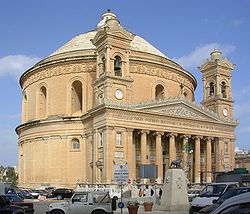- Rotunda of Mosta
-
Rotunda of St Marija Assunta
Knisja Arċipretali Ta’ Santa Marija (Maltese)
Facade of the Rotunda of St Marija Assunta.
Basic information Location  Mosta, Malta
Mosta, MaltaGeographic coordinates 35°54′36.29″N 14°25′33.24″E / 35.9100806°N 14.4259°ECoordinates: 35°54′36.29″N 14°25′33.24″E / 35.9100806°N 14.4259°E Affiliation Roman Catholic Year consecrated 1871 Ecclesiastical or organizational status Parish Architectural description Architect(s) Giorgio Grognet de Vassé Architectural type Church Direction of façade SSE Groundbreaking 1614 Completed 1860s Specifications Length 75 metres (246 ft) Width 55 metres (180 ft) The Church of the Assumption of Our Lady, commonly known as the Rotunda of Mosta or Rotunda of St Marija Assunta (sometimes shortened to as The Mosta Dome) is a Roman Catholic church in Mosta, Malta. It is the third largest unsupported dome in the world[citation needed].
Built in the 19th century on the site of a previous church, it was designed by the Maltese architect Giorgio Grognet de Vassé. Its dome is among the largest in the world, with an internal diameter of 37.2 metres (122 ft)[1][2]. The rotunda walls are nearly 9.1 metres (30 ft) thick[1]. The rotunda dome is the third-largest church dome in Europe and the ninth largest in the world.
Grongnet's plans were based on the Pantheon in Rome. Construction began in May 1833 and was completed in the 1860s. The original church was left in place while the Rotunda was built around it, allowing the local people to have a place of worship while the new church was being built. The church was officially consecrated the 15 October 1871[3].
Contents
Mosta bomb miracle
On April 9, 1942, during an afternoon air-raid, a 200 kg Luftwaffe bomb pierced the dome (two others bounced off) and fell among a congregation of more than 300 people awaiting early evening mass. It did not explode. Its replica is now on display inside the rotunda under the words Il-Miraklu tal-Bomba, 9 ta' April 1942 (Maltese: The Bomb Miracle, April 9, 1942).
One version of this event states that, upon opening the bomb, it was found to be filled with sand instead of explosive and contained a note saying "greetings from Plzeň" from the workers at Škoda Works in the German-occupied Czechoslovakia (then Protectorate of Bohemia and Moravia) who had allegedly sabotaged its production[citation needed].
Gallery
Notes
- ^ a b Macdonald 2002, p. 156
- ^ Cauchi 1988, p. 79
- ^ http://maltadiocese.org/lang/en/parishes/mosta/
See also
- List of Churches in Malta
- List of largest domes in the world
References
- Macdonald, William (2002). The Pantheon:design, meaning, and progeny. New York: Knopf Books for Young Readers. ISBN 9780674010192. http://books.google.com/books?id=vjKDS_XoPXQC&pg=PA156.
- Cauchi, Raymond (1988). The Mosta Rotunda: short history & guide. Cauchi's Emporium. http://books.google.com/books?id=DlG0AAAAIAAJ.
External links
Categories:- 19th-century church buildings
- Churches in Malta
- Domes
- Maltese architecture
- Rotundas
- Malta stubs
- European building and structure stubs
Wikimedia Foundation. 2010.


